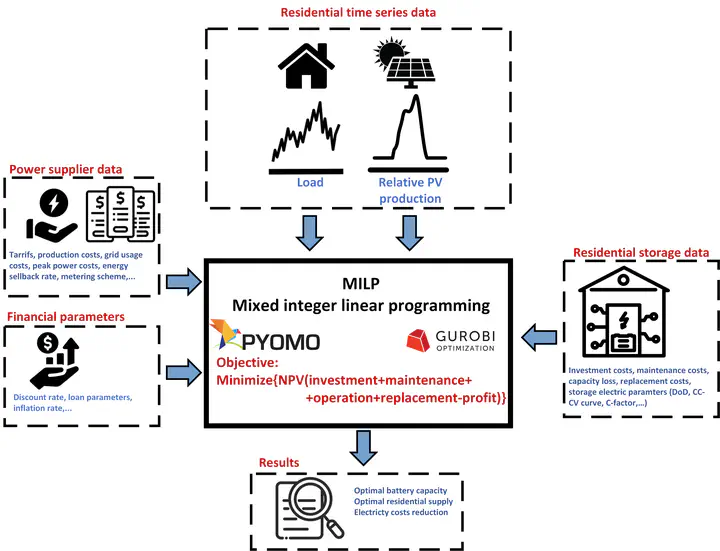Evaluating the Impact of Sellback Rates and Metering Schemes on Battery Storage Size in Grid-Connected PV Systems
 Image credit: Unsplash
Image credit: UnsplashAbstract
As residential photovoltaic (PV) systems continue to increase, integrating battery storage emerges as a critical strategy for enhancing system efficiency and grid stability. This paper underscores the significance of incorporating battery storage in grid-connected residential PV systems. Specifically, it delves into the optimal sizing of battery storage for homes equipped with PV plants. Through an extensive investigation, the paper investigates the impact of varying energy sellback prices, different net metering/billing schemes, and battery storage investment costs on the determination of optimal battery capacity for residential consumers. To address this complex optimization challenge, a mixed integer linear program (MILP) model is formulated, providing a systematic framework for decision-making. The paper’s findings offer valuable insights into the interplay between financial incentives, regulatory mechanisms, and technological factors in shaping the optimal configuration of residential PVbattery systems.
SST 2024 : Evaluating Battery Storage in Residential PV Systems
This talk, presented by Damir Jakus and co-authored by experts from FESB, Split, Croatia, will explore how varying energy sellback prices, net metering/billing schemes, and battery storage investment costs influence the optimal sizing of battery storage in residential photovoltaic (PV) systems.
Key discussion points include:
- Insights from a mixed integer linear programming (MILP) model for battery optimization
- Case studies from Croatia, highlighting different net metering/billing schemes
- The potential for battery integration to reduce energy costs under varying conditions
As the adoption of residential PV systems continues to rise, battery storage has become an essential component for enhancing energy efficiency and grid stability. This session will delve into the core factors that influence the optimal sizing of battery storage, focusing on key elements such as:
- Energy Sellback Rates: How varying rates for selling excess energy back to the grid can impact the economic feasibility of battery storage.
- Net Metering and Billing Schemes: An exploration of monthly net metering/billing versus 15-minute interval net billing, with case studies from Croatia that reveal how these schemes affect both residential and business consumers.
- Battery Storage Investment Costs: Analysis of how declining battery storage costs are reshaping the energy landscape and the implications for residential PV systems.
- Optimization Model: An introduction to the mixed integer linear programming (MILP) model developed to optimize battery capacity in grid-connected PV systems, offering a systematic framework for decision-making.
This session will provide valuable information for policymakers, engineers, and homeowners interested in optimizing residential solar energy systems. Don’t miss this opportunity to deepen your understanding of the intersection between renewable energy technology and financial incentives.
Date: 16-18 October 202
Location: Osijek, Croatia
For more details, visit Conference Website.